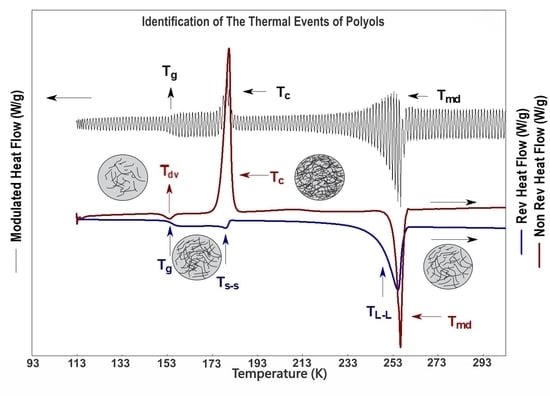Thermal Study of Polyols for the Technological Application as Plasticizers in Food Industry
Abstract
:1. Introduction
2. Materials and Methods
2.1. Materials
2.2. Thermogravimetric (TGA), and Differential Thermal Analysis (DTA)
2.3. Differential Scanning Calorimetry (DSC) and Modulated DSC (MDSC)
2.4. MDSC at Supercooling Temperature (SMDSC)
3. Results and Discussion
3.1. Simultaneous Thermal Analysis (TGA-DTA)
3.2. DSC, MDSC, and S-MDSC Analysis
4. Conclusions
Author Contributions
Acknowledgments
Conflicts of Interest
References
- Adeodato Vieira, M.G.; Da Silva, M.A.; Dos Santos, L.O.; Beppu, M.M. Natural-based plasticizers and biopolymer films: A review. Eur. Polym. J. 2011, 47, 254–263. [Google Scholar] [CrossRef]
- Lin, D.; Zhao, Y. Innovations in the development and application of edible coatings for fresh and minimally processed fruits and vegetables. Compr. Rev. Food Sci. F 2007, 6, 60–75. [Google Scholar] [CrossRef]
- Han, J.H. Edible films and coatings: A review. In Innovations in Food Packaging, 2nd ed.; Elsevier Academic Press: San Diego, CA, USA, 2013; pp. 213–255. ISBN 9780123946010. [Google Scholar]
- Snejdrova, E.; Dittrich, M. Pharmaceutically used plasticizers. In Recent Advances in Plasticizers; Luqman, M., Ed.; IntechOpen: Rijeka, Croatia, 2012; pp. 45–68. ISBN 978-953-51-0363-9. [Google Scholar]
- Gontard, N.; Guilbert, S.; Cuq, J.L. Edible wheat gluten films influence of the main process variables on film properties using surface response methodology. J. Food Sci. 1992, 57, 190–195. [Google Scholar] [CrossRef]
- Sobral, P.J.A.; Menegalli, F.C.; Hubinger, M.D.; Roques, M.A. Mechanical, water vapor barrier and thermal properties of gelatin based edible film. Food Hydrocoll. 2001, 15, 423–432. [Google Scholar] [CrossRef]
- Baldwin, E.A.; Baker, R.A. Use of proteins in edible coatings for whole and minimally processed fruits and vegetables. In Protein-Based Films and Coatings; Gennadios, A., Ed.; CRC Press: Boca Raton, FL, USA, 2002; pp. 501–515. ISBN 9781587161070. [Google Scholar]
- Cao, N.; Yang, X.; Fu, Y. Effects of various plasticizers on mechanical and water vapor barrier properties of gelatin films. Food Hydrocoll. 2009, 23, 729–735. [Google Scholar] [CrossRef]
- Casariego, A.; Díaz, R.; Sergrañes, Y.; Nieto, O.M.; Durán, C.; López, N.; Rodríguez, M.; González, J. Modelación de las propiedades mecánicas de películas de quitosana. Cienc. Tecnol. Aliment. 2009, 19, 7–12. [Google Scholar]
- Domínguez-Courtney, M.F.; Jiménez-Munguía, M.T. Películas comestibles formuladas con polisacáridos: Propiedades y aplicaciones. Temas Sel. Ingeniería Aliment. 2012, 6, 110–121. [Google Scholar]
- Blanshard, J.M.V. The glass transition, its nature and significance in food processing. In Physico-Chemical Aspects of Food Processing; Beckett, S.T., Ed.; Chapman & Hall: London, UK, 1995; pp. 17–48. ISBN 978-1-4612-8521-2. [Google Scholar]
- Saavedra-Leos, M.Z.; Grajales-Lagunes, A.; González-García, R.; Toxqui-Terán, A.; Pérez-García, S.A.; Abud-Archila, M.A.; Ruiz-Cabrera, M.A. Glass transition study in model food systems prepared with mixtures of fructose, glucose, and sucrose. J. Food Sci. 2012, 77, E118–E126. [Google Scholar] [CrossRef] [PubMed]
- Parker, R.; Ring, S.G. Aspects of the physical chemistry of starch. J. Cereal Sci. 2001, 34, 1–17. [Google Scholar] [CrossRef]
- Andersen, P.J.; Hodson, S. Thermoplastic Starch Compositions Incorporating a Particulate Filler Component. U.S. Patent 6,231,970, 15 May 2001. [Google Scholar]
- Orliac, O.; Rouilly, A.; Silvestre, F.; Rigal, L. Effects of various plasticizers on the mechanical properties, water resistance and aging of thermo-moulded films made from sunflower proteins. Ind. Crops Prod. 2003, 18, 91–100. [Google Scholar] [CrossRef]
- Suyatma, N.E.; Tighzert, L.; Copinet, A.; Coma, V. Effects of hydrophilic plasticizers on mechanical, thermal, and surface properties of chitosan films. J. Agric. Food Chem. 2005, 53, 3950–3957. [Google Scholar] [CrossRef] [PubMed]
- Vanin, F.M.; Sobral, P.J.A.; Menegalli, F.C.; Carvalho, A.; Habitante, A.M.Q.B. Effects of plasticizers and their concentrations on thermal and functional properties of gelatin-based films. Food Hydrocoll. 2005, 19, 899–907. [Google Scholar] [CrossRef]
- Da Róz, A.L.; Carvalho, A.J.F.; Gandini, A.; Curvelo, A.A.S. The effect of plasticizers on thermoplastic starch compositions obtained by melt processing. Carbohydr. Polym. 2006, 63, 417–424. [Google Scholar] [CrossRef]
- Ma, X.; Yu, J. The effects of plasticizers containing amide groups on the properties of thermoplastic starch. Starch 2004, 56, 545–551. [Google Scholar] [CrossRef]
- Smits, A.L.M.; Kruiskamp, P.H.; Van Soest, J.J.G.; Vliegenthart, J.F.G. Interaction between dry starch and glycerol or ethylene glycol, measured by differential scanning calorimetry and solid state NMR spectroscopy. Carbohydr. Polym. 2003, 53, 409–416. [Google Scholar] [CrossRef]
- Tang, X.; Alavi, S.; Herald, T.J. Effects of plasticizers on the structure and properties of starch–clay nanocomposite films. Carbohydr. Polym. 2008, 74, 552–558. [Google Scholar] [CrossRef]
- Alves, V.D.; Mali, S.; Beléia, S.; Grossmann, M.V.E. Effect of glycerol and amylose enrichment on cassava starch film properties. J. Food Eng. 2007, 78, 941–946. [Google Scholar] [CrossRef]
- Mantzari, G.; Raphaelides, S.N.; Exarhopoulos, S. Effect of sorbitol addition on the physicochemical characteristics of starch–fatty acid systems. Carbohydr. Polym. 2010, 79, 154–163. [Google Scholar] [CrossRef]
- Agency for Toxic Substances and Disease Registry (ATSDR). Toxicological Profile for Ethylene Glycol; U.S. Department of Health and Human Services, Public Health Service: Atlanta, GA, USA, 2010.
- Krasowski, M.D.; Wilcoxon, R.M.; Miron, J. A retrospective analysis of glycol and toxic alcohol ingestion: Utility of anion and osmolal gaps. BMC Clin. Pathol. 2012, 12, 1–10. [Google Scholar] [CrossRef] [PubMed]
- Ryabov, Y.E.; Hayashi, Y.; Gutina, A.; Feldman, Y. Features of supercooled glycerol dynamics. Phys. Rev. B 2004, 69, 189904. [Google Scholar] [CrossRef]
- Takeda, K.; Murata, K.; Yamashita, S. Thermodynamic investigation of glass transition in binary polyalcohols. J. Non-Cryst. Solids 1998, 231, 273–279. [Google Scholar] [CrossRef]
- Yuan, H.; Xia, T.; Plazanet, M.; Deme, B.; Orrit, M. Crystallite nucleation in supercooled glycerol near the glass transition. J. Chem. Phys. 2012, 136, 041102. [Google Scholar] [CrossRef] [PubMed]
- Sou, K.; Nishikawa, K.; Koga, Y.; Tozaki, K.I. High-resolution calorimetry on thermal behavior of glycerol (I): Glass transition, crystallization and melting, and discovery of a solid–solid transition. Chem. Phys. Lett. 2011, 506, 217–220. [Google Scholar] [CrossRef]
- Badrinarayana, P.; Zheng, W.; Li, Q.X.; Simon, S.L. The glass transition temperature versus the fictive temperature. J. Non-Cryst. Solids 2007, 353, 2603–2612. [Google Scholar] [CrossRef]
- Takeda, K.; Yamamuro, O.; Tsukushi, I.; Matsuo, T.; Suga, H. Calorimetric study of ethylene glycol and 1, 3-propanediol: Configurational entropy in supercooled polyalcohols. J. Mol. Struct. 1999, 479, 227–235. [Google Scholar] [CrossRef]
- Carpentier, L.; Bustin, O.; Descamps, M. Temperature-modulated differential scanning calorimetry as a specific heat spectroscopy. J. Phys. D Appl. Phys. 2002, 35, 402–408. [Google Scholar] [CrossRef]
- Möbius, M.E.; Xia, T.; Van Saarloos, W.; Orrit, M.; Van Hecke, M. Aging and solidification of supercooled glycerol. J. Phys. Chem. B 2010, 114, 7439–7444. [Google Scholar] [CrossRef] [PubMed]
- Birge, N.O. Specific-heat spectroscopy of glycerol and propylene glycol near the glass transition. Phys. Rev. B 1986, 34, 1631–1642. [Google Scholar] [CrossRef]
- Dou, B.; Dupont, V.; Williams, P.T.; Chen, H.; Ding, Y. Thermogravimetric kinetics of crude glycerol. Bioresour. Technol. 2009, 100, 2613–2620. [Google Scholar] [CrossRef] [PubMed]
- Agarwal, G.; Lattimer, B. Method for measuring the standard heat of decomposition of materials. Thermochim. Acta 2012, 545, 34–47. [Google Scholar] [CrossRef]
- Verdonck, E.; Schaap, K.; Thomas, L.C. A discussion of the principles and applications of modulated temperature DSC (MTDSC). Int. J. Pharm. 1999, 192, 3–20. [Google Scholar] [CrossRef]
- Rahman, M.S. State diagram of foods: Its potential use in food processing and product stability. Trends Food Sci. Technol. 2006, 17, 129–141. [Google Scholar] [CrossRef]
- Sablani, S.S.; Syamaladevi, R.M.; Swanson, B.G. A review of methods, data and applications of state diagrams of food systems. Food Eng. Rev. 2010, 2, 168–203. [Google Scholar] [CrossRef]
- Hempel, E.; Hempel, G.; Hensel, A.; Schick, C.; Donth, E. Characteristic length of dynamic glass transition near Tg for a wide assortment of glass-forming substances. J. Phys. Chem. B. 2000, 104, 2460–2466. [Google Scholar] [CrossRef]
- Wowk, B. Thermodynamic aspects of vitrification. Cryobiology 2010, 60, 11–22. [Google Scholar] [CrossRef] [PubMed]
- Boyer, R.F.; Heeschen, J.P.; Gillham, J.K. Comments on a paper by Axelson and Mandelkern concerning 13C NMR spectra of polymers. J. Polym. Sci. Polym. Phys. Ed. 1981, 19, 13–21. [Google Scholar] [CrossRef]
- Baudot, A.; Odagescu, V. Thermal properties of ethylene glycol aqueous solutions. Cryobiology 2004, 48, 283–294. [Google Scholar] [CrossRef] [PubMed]
- Achete, C.A. Measurement of the specific heat capacity of copper nanofluids by modulated temperature differential scanning calorimetry. In 13th Brazilian Congress of Thermal Sciences and Engineering, Uberlandia; OCP Science: Minas Gerais, Brazil, 2012. [Google Scholar]
- Sláma, I.; Malá, J. Induction period of crystallization of zinc chloride solutions in ethylene glycol. Collect. Czech. Chem. Commun. 1990, 55, 2428–2431. [Google Scholar] [CrossRef]
- Bronshteyn, V.L.; Steponkus, P.L. Nucleation and growth of ice crystals in concentrated solutions of ethylene glycol. Cryobiology 1995, 32, 1–22. [Google Scholar] [CrossRef]
- Mehl, P.M. Determination of enthalpy relaxation times using traditional differential scanning calorimetry for glycerol and for propylene glycol. Thermochim. Acta 1996, 272, 201–209. [Google Scholar] [CrossRef]
- Zhivotova, E.N.; Zinchenko, A.V.; Kuleshova, L.G.; Chekanova, V.V.; Kompaniets, A.M. Physical states of aqueous solutions of oxyethylated glycerol with polymerization degree of n = 30 at temperatures lower than 283 K. CryoLetters 2007, 28, 261–270. [Google Scholar] [PubMed]
- Fahy, G.M.; MacFarlane, D.R.; Angell, C.A.; Meryman, H.T. Vitrification as an approach to cryopreservation. Cryobiology 1984, 21, 407–426. [Google Scholar] [CrossRef]
- Mo, X.; Sun, X. Plasticization of soy protein polymer by polyol-based plasticizers. J. Am. Oil Chem. Soc. 2002, 79, 197–202. [Google Scholar] [CrossRef]
- Somwanshi, S.B.; Dolas, R.T.; Wagh, V.D.; Kotade, K.B. Pharmaceutically Used Plasticizers: A Review. Eur. J. Biomed. Pharm. Sci. 2016, 3, 277–285. [Google Scholar]
- Mishra, A.; Pathak, A.K. Plasticizers: A vital excipient in novel pharmaceutical formulations. Curr. Res. Pharm. Sci. 2017, 7, 1–10. [Google Scholar] [CrossRef]
- Harper, C.A. Modern Plastics Handbook; McGraw-Hill Professional: New York, NY, USA, 2000; pp. 2.1–2.88. ISBN 0-07-026714-6. [Google Scholar]
- Zhao, L.S.; Cao, Z.X.; Wang, Q. Glass transition of aqueous solutions involving annealing-induced ice recrystallization resolves liquid-liquid transition puzzle of water. Sci. Rep. 2015, 5, 1–8. [Google Scholar] [CrossRef] [PubMed]
- Isachenko, E.; Isachenko, V.; Katkov, I.I.; Dessole, S.; Nawroth, F. Vitrification of mammalian spermatozoa in the absence of cryoprotectants: From past practical difficulties to present success. Reprod. Biomed. Online 2003, 6, 191–200. [Google Scholar] [CrossRef]
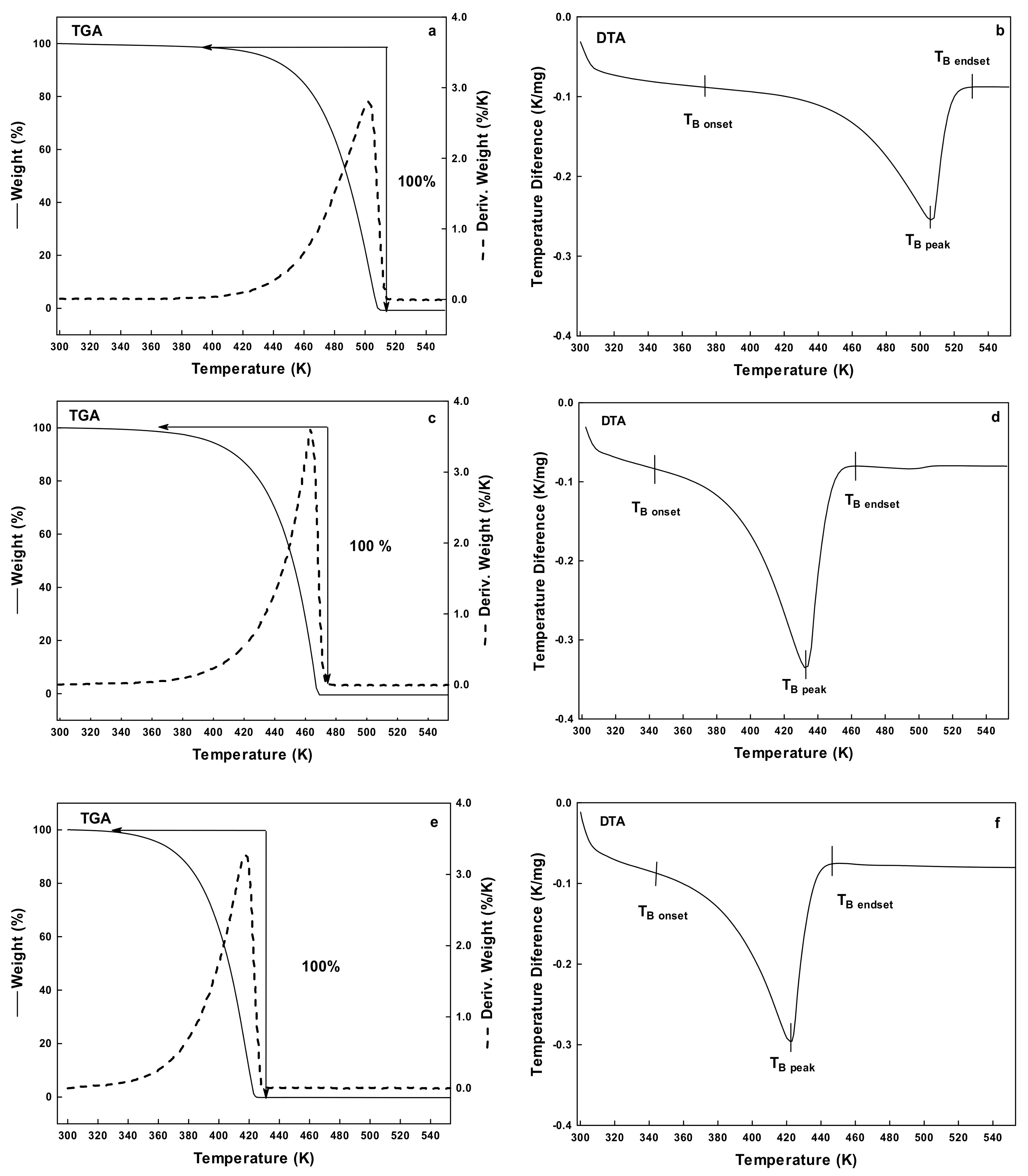
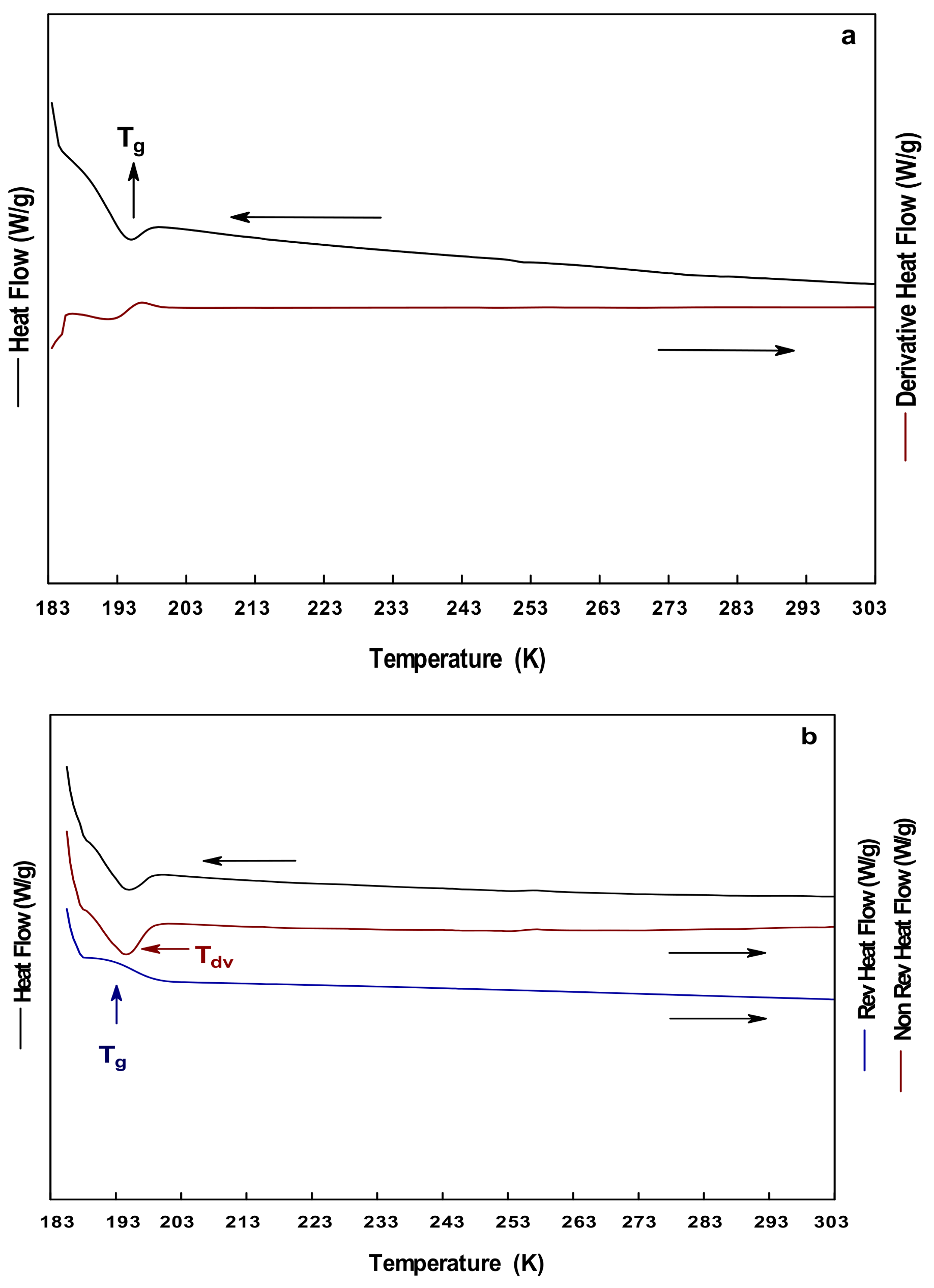
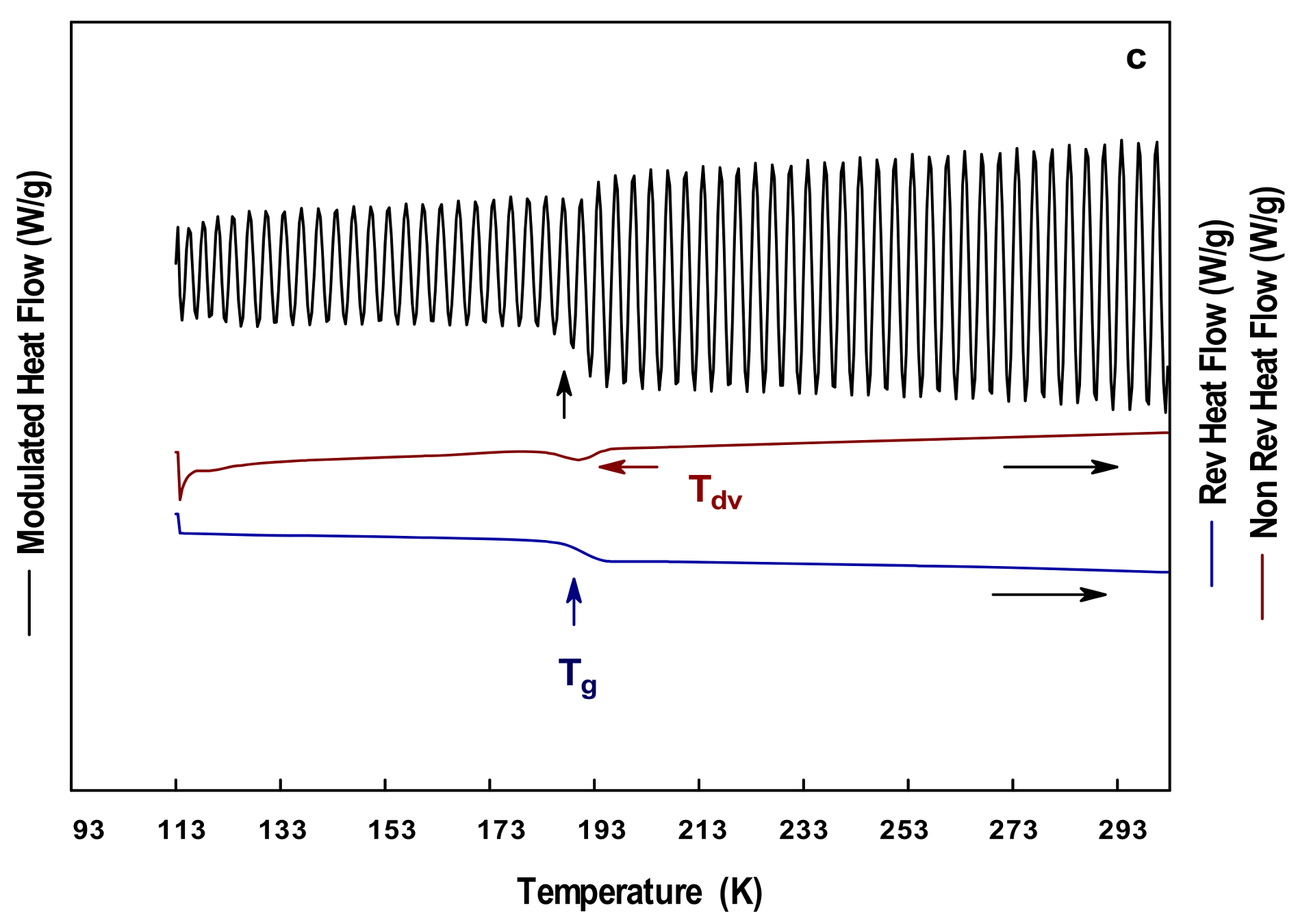
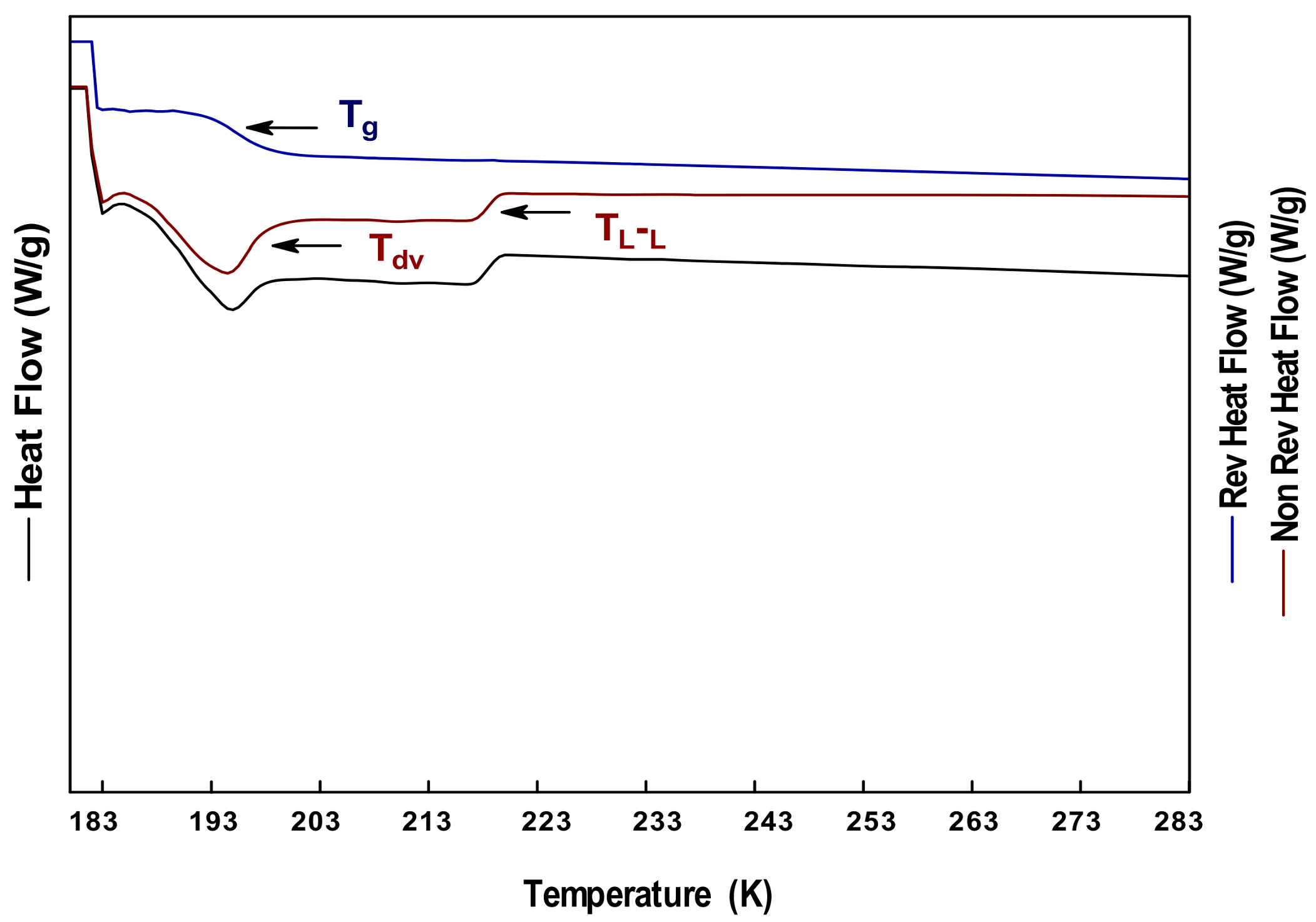

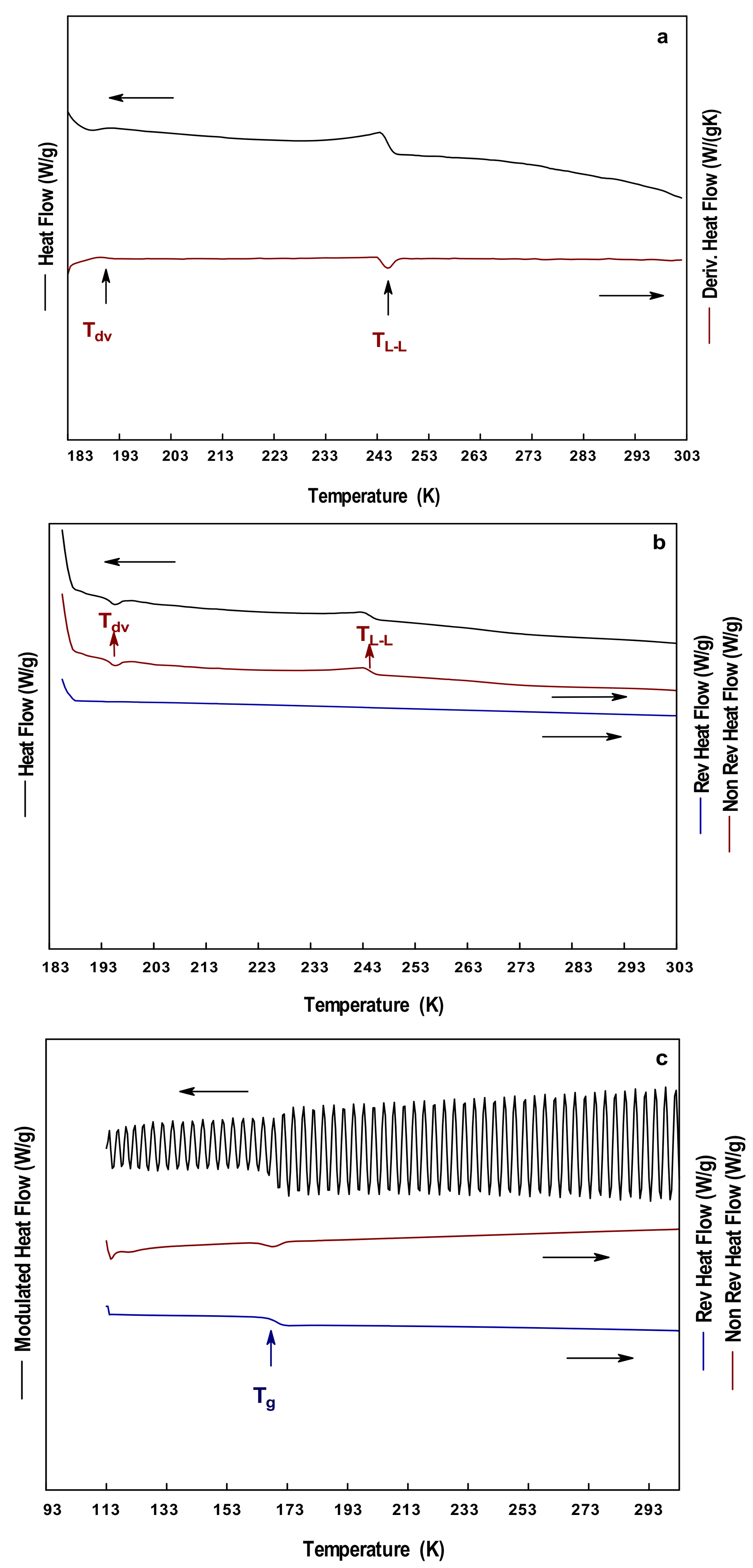
| Heating Rate (K/min) | |||||||
|---|---|---|---|---|---|---|---|
| TGA | DTA | ||||||
| 275 | 278 | 283 | 275 | 278 | 283 | ||
| GLY | Mass loss (%) | 373 ± 1.4 | 373 ± 7.9 | 373 ± 2.9 | - | - | - |
| Initial mass loss temperature (K) | 313 ± 2.8 | 398 ± 5.6 | 407 ± 3.1 | 374 ± 0.6 | 393 ± 2.1 | 412 ± 2.7 | |
| Maximum mass loss temperature (K) | 483 ± 1.6 | 502 ± 4.3 | 522 ± 2.4 | 488 ±1.2 | 506 ± 3.8 | 529 ± 5.6 | |
| Final mass loss temperature (K) | 495 ± 3.5 | 511 ± 5.1 | 538 ± 5.1 | 493 ± 3.4 | 531 ± 2.4 | 552 ± 6.1 | |
| EG | Mass loss (%) | 373 ± 7.1 | 373 ± 2.5 | 373 ± 4.3 | - | - | - |
| Initial mass loss temperature (K) | 331 ± 4.7 | 338 ± 3.7 | 345 ± 4.8 | 332 ± 2.0 | 338 ± 0.8 | 345 ± 2.1 | |
| Maximum mass loss temperature (K) | 410 ± 6.3 | 427 ± 1.4 | 442 ± 3.8 | 413 ± 2.8 | 433 ± 0.4 | 457 ± 1.8 | |
| Final mass loss temperature (K) | 417 ± 2.1 | 442 ± 3.1 | 457 ± 3.3 | 425 ± 1.4 | 459 ± 1.7 | 496 ± 1.5 | |
| PG | Mass loss (%) | 373 ± 4.6 | 373 ± 3.9 | 373 ± 4.5 | - | - | - |
| Initial mass loss temperature (K) | 323 ± 2.3 | 333 ± 2.7 | 334 ± 7.7 | 325 ± 3.4 | 333 ± 2.8 | 403 ± 6.1 | |
| Maximum mass loss temperature (K) | 401 ± 2.8 | 418 ± 1.0 | 431 ± 0.6 | 404 ± 4.0 | 422 ± 4.8 | 436 ± 5.0 | |
| Final mass loss temperature (K) | 410 ± 0.9 | 429 ± 2.1 | 444 ± 0.4 | 416 ± 2.9 | 448 ± 3.5 | 480 ± 1.0 | |
| Polyol | Thermal Event (K) | ||||||
|---|---|---|---|---|---|---|---|
| Tg | Tdv | Tc | Ts-s | TL-L | Tm | TB | |
| GL | 191–199 | 197 | - | - | 215–221 | - | 513.15 |
| EG | 154 | 154 | 175 | 178 | 255 | 255 | 437.15 |
| PG | 167 | 193 | - | - | 245 | - | 431.15 |
© 2018 by the authors. Licensee MDPI, Basel, Switzerland. This article is an open access article distributed under the terms and conditions of the Creative Commons Attribution (CC BY) license (http://creativecommons.org/licenses/by/4.0/).
Share and Cite
Toxqui-Terán, A.; Leyva-Porras, C.; Ruíz-Cabrera, M.Á.; Cruz-Alcantar, P.; Saavedra-Leos, M.Z. Thermal Study of Polyols for the Technological Application as Plasticizers in Food Industry. Polymers 2018, 10, 467. https://doi.org/10.3390/polym10050467
Toxqui-Terán A, Leyva-Porras C, Ruíz-Cabrera MÁ, Cruz-Alcantar P, Saavedra-Leos MZ. Thermal Study of Polyols for the Technological Application as Plasticizers in Food Industry. Polymers. 2018; 10(5):467. https://doi.org/10.3390/polym10050467
Chicago/Turabian StyleToxqui-Terán, Alberto, César Leyva-Porras, Miguel Ángel Ruíz-Cabrera, Pedro Cruz-Alcantar, and María Zenaida Saavedra-Leos. 2018. "Thermal Study of Polyols for the Technological Application as Plasticizers in Food Industry" Polymers 10, no. 5: 467. https://doi.org/10.3390/polym10050467






